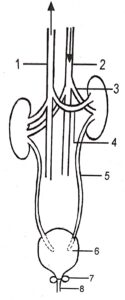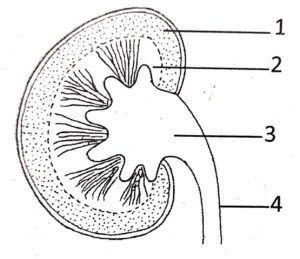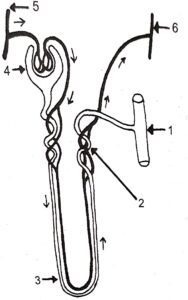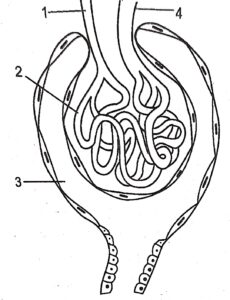Excretory System Class-10 Long and Structured Goyal Brothers ICSE Biology Solutions Ch-9 . We Provide Solutions of Long Answer and Structured Questions of Exercise-9 The Excretory System. All solutions are given as council prescribe guideline for next upcoming exam. Visit official Website CISCE for detail information about ICSE Board Class-10 Biology.
Ch-9 The Excretory System Goyal Brothers Prakashan ICSE Class-10 Biology Solutions
| Board | ICSE |
| Publications | Goyal Brothers publications |
| Subject | Biology |
| Class | 10th |
| Writer | Dr. K.K. Aggrawal |
| Chapter-9 | The Excretory System |
| Topics | Solutions of Long Answer and Structured Questions |
| Edition | for 2022-2023 Academic Session |
Note :- Before Viewing Goyal Brothers Solutions of Chapter-9 The Excretory System . Read the whole chapter carefully with figure and make a self written note , highlight the important point.
D. LONG ANSWER QUESTIONS
Ch-9 The Excretory System Goyal Brothers Prakashan ICSE Class-10 Biology Solutions
(Page-126)
Question 1. What is the role of skin , lungs and liver in the process of excretion in human beings ?
Answer : Organs like lungs , liver and skin also play a role in excretion. Lungs – Lungs remove large amounts of carbon dioxide and significant amount of water everyday. Liver – The liver helps in the excretion of cholesterol, steroid hormones, vitamins, drugs, and other waste materials through bile.
Question 2. Give the principle involved in the functioning of an artificial kidney machine to clean the blood.
Answer : Artificial kidney works on the principle of dilaysis in which waste products such as creatinine and urea,as well as free water from the blood are removed
Question 3. Give a brief of wastes excreted out by human.
Answer : The major wastes produced by us are: Carbon dioxide and Urea. Carbon dioxide is produced by the process of respiration and urea is produced by the decomposition of unused proteins in the liver. There are different organs which removes waste from the body. These are lungs and kidneys
Question 4. What remedial measures are followed if a person is showing symptoms of dehydration?
Answer : Dehydration must be treated by replenishing the fluid level in the body. This can be done by consuming clear fluids such as water, clear broths, frozen water or ice pops, or sports drinks (such as Gatorade). Some dehydration patients, however, will require intravenous fluids in order to rehydrate
Question 5. Why is osmoregulation important?
Answer : Water is an important component for life and the process of osmoregulation helps to maintain balance between water and minerals at the cellular level. In humans, the osmoregulation (osmotic pressure in blood) is handled by the kidneys
Question 6. Draw a well labelled diagram of a nephron.
Answer : please see fig-9.3 structure of neuron in your text book
Question 7. Show the following structures in a diagram of the human excretory system:
Renal cortex, medulla and pelvis.
Answer : please see fig-9.2 internal structure of kidney in your text book
E. STRUCTURED QUESTIONS
Ch-9 The Excretory System Goyal Brothers Prakashan ICSE Class-10 Biology Solutions
(Page-126)
Question 1. The diagram given below shows the excretory system of a human being. Study the same and then answer the questions that follow:

(i) Name the parts labelled 1, 2, 3 and 4.
(ii) Give the main function of the parts labelled 5, 6, 7 and 8.
(iii) Name the endocrine gland which could be added in the diagram and state its location/position.
Answer :
(i) 1—Posterior Vena Cava
2—Aorta
3—Renal Artery
4—Renal Vein
(ii) Part 5 : Ureter – Carry urine from kidneys to urinary bladder.
Part 6 : Urinary bladder – Contain the urine till it is released out.
Part 7: Sphincter muscles – Guards the urethra
Part 8: Urethra – Passage through which urine is given out of the body.
(iii) Adrenal gland. It is located above each kidney in the form of a cap.
Question 2. The diagram given below shows a section of a human kidney. Study the diagram carefully and answer the questions that follow :

(i) Label the parts numbered 1 to 4.
(ii) Why does part ‘2’ have a striped appearance ?
(iii) What is the fluid that passes down part ‘4’ ? Name the main nitrogenous waste present in it.
(iv) Mention the structural and functional units of kidneys.
(v) Name the two major steps in the formation of the fluid mentioned in Q. 5. (a) (iii).
Answer :
(i) 1. Cortex 2. Medulla 3. Pelvis 4. Ureter.
(ii) Part 2 (Medulla) has the loop of Henle of all the nephrons. So they have appearance like stripes.
(iii) Urine, Urea.
(iv) Nephron/Kidney tubule/Renal tubule.
(v) 1. Ultrafiltration and 2. Selective Readsorption.
Question 3. The given diagram represents a nephron and its blood supply. Study the diagram and answer the following questions :

(i) Label parts 1, 2, 3 and 4.
(ii) State the reason for the high hydrostatic pressure in the glomerulus.
(iii) Name the blood vessel which contains the least amount of urea in this diagram.
(iv) Name the two main stages of urine formation.
(v) Name the part of the nephron which lies in the renal medulla.
Answer :
(i) 1. Collecting duct.
2. Distal convoluted tubule.
3. Loop of Henle.
4. Bowman’s capsule.
(ii) The afferent arteriole splits into many fine branches due to which the volume of capillaries reduce thus raising the hydrostatic pressure in the glomerulus.
(iii) Blood vessel 6-Efferent arteriole that connects to renal vein.
(iv) 1. Ultrafiltration.
2. Selective Reabsorption.
(v) Loop of Henle.
Question 4. Study the diagram given below and then answer the questions that follow :

(i) Name the region is the kidney where the above structure is present ?
(ii) Name the parts labelled 1, 2, 3 and 4.
(iii) Name the stages involved in the formation of urine
(iv) What is the technical term given to the process occurring in 2 and 3 ? Briefly describe the process.
Answer :
(i) Cortex
(ii) 1 – Afferent arteriole
2 – Glomerulus
3 – Bowman’s capsule
4 – Efferent arteriole
(iii) Ultrafiltration Selective reabsorption Tubular secretion
(iv) Ultrafiltration.
Blood rich in nitrogenous waste and excess water enters Bowmans Capsule through a wider afferent arteriole then splits into fine capillaries called glomerulus due to which a hydrostatic pressure is created. This pressure leads to filtration of water with nitrogenous wastes.
— : End of Excretory System Class-10 Long and Structured Goyal Brothers ICSE Biology Solutions :–
Return to :- ICSE Biology for Class 10 Goyal Brothers Prakashan solutions


